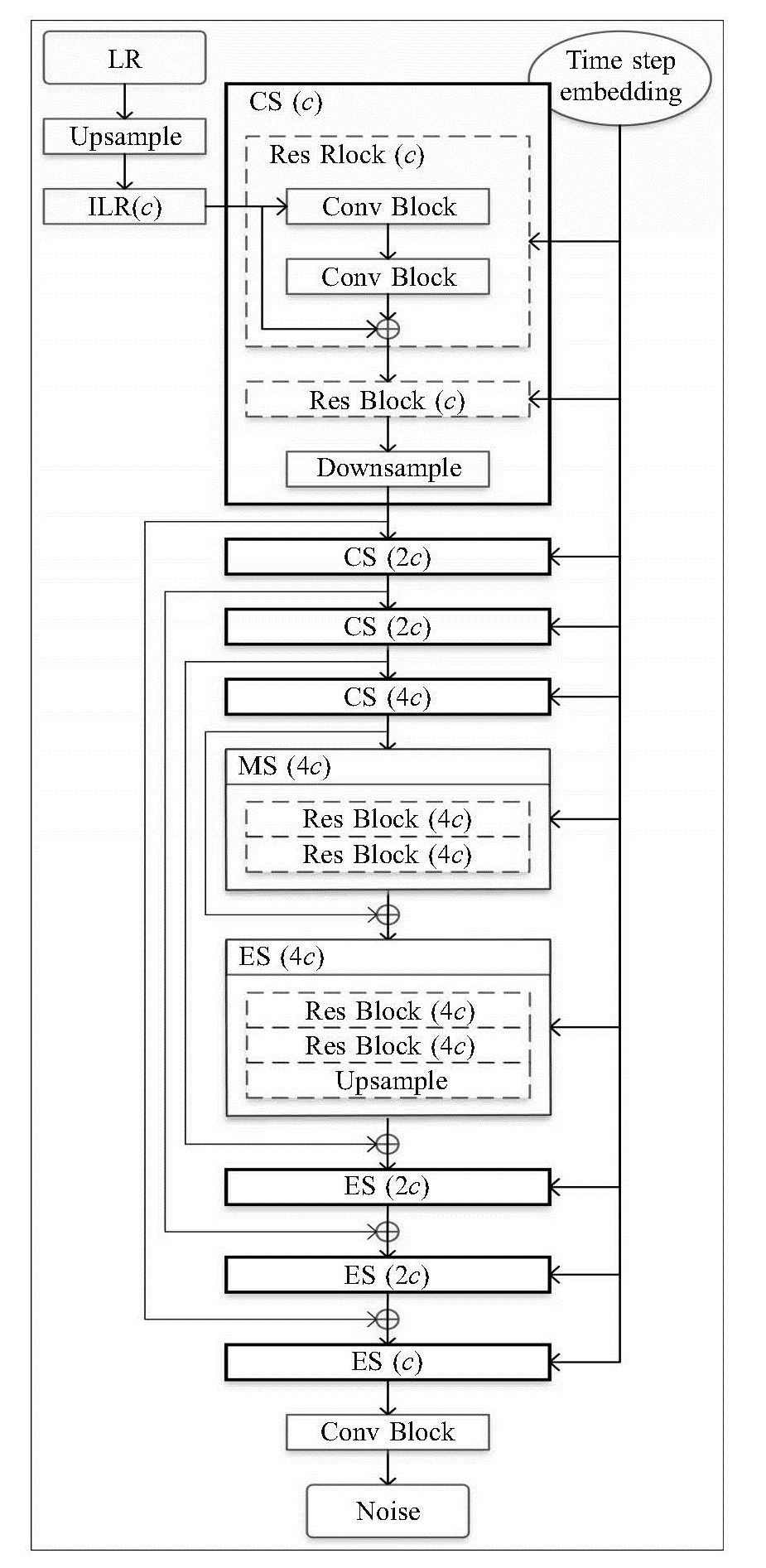A Spatial Downscaling Method for Numerical Model Prediction Based on Residual Shift Diffusion Model
-
摘要: 数值模式预报在气象预测中占据核心地位,利用深度学习技术提升预报的空间精度是空间降尺度的重要发展方向之一。然而,传统生成式模型存在计算效率低、空间纹理精度不足以及模式坍塌等问题。为了解决这些问题,提出了一种基于残差移位扩散模型的数值模式预报空间降尺度方法。具体而言,将残差引入扩散模型的扩散过程中,帮助模型快速收敛,减少采样步骤,相比潜空间扩散模型,推理时间缩短到四十分之一,有效提高了计算效率。通过扩散模型逐步去噪的过程,生成高质量和细节丰富的降尺度图像,显著提升了空间细节表现力。此外,设计了一个噪声灵活控制机制,有效缓解了模式坍塌问题,保证了生成图像的多样性。在与生成对抗模型的对比试验中,本方法在峰值信噪比(PSNR)、结构相似性(SSIM)和图像感知相似度(LPIPS)等指标上分别实现了6%、12%和16%的显著提升。通过这一方法,有望为气象敏感行业提供更准确、更精细的天气信息,推动相关领域的技术进步。Abstract: Numerical weather prediction (NWP) plays a central role in meteorological forecasting, and enhancing spatial resolution using deep learning techniques is a key direction in spatial downscaling. However, traditional generative models often suffer from low computational efficiency, insufficient spatial texture accuracy, and mode collapse. To address these issues, this paper proposed a spatial downscaling method for NWP based on a residual shift diffusion model. Specifically, we introduced residuals into the model' s diffusion process, aiding in quicker convergence and reducing the number of sampling steps. Unlike latent space diffusion models, our approach decreases inference time by a factor of 40, thereby significantly enhancing computational efficiency. The step-by-step denoising process of the diffusion model generated high-quality, detail-rich downscaled images, thereby enhancing the representation of spatial details. Furthermore, we designed a flexible noise control mechanism that effectively mitigated mode collapse, thereby ensuring the diversity of the generated images. In comparative experiments with generative adversarial models, our method significantly improved peak signal-to-noise ratio, structural similarity, and learned perceptual image patch similarity by 6%, 12%, and 16%, respectively. This approach promises to provide more accurate and detailed weather information for weather-sensitive industries, driving technological advancements in related fields.
-
Key words:
- spatial downscaling /
- diffusion model /
- noise control /
- residual shift /
- numerical weather prediction
-
表 1 不同配置下Temresnet在Temresnet_test上的性能比较
配置 性能指标 T p k PSNR↑ SSIM↑ LPIPS↓ 10 30.19 0.729 0.242 15 0.3 2.0 30.01 0.716 0.221 30 29.75 0.701 0.216 0.3 30.01 0.716 0.221 15 0.5 2.0 30.06 0.712 0.222 1.0 30.13 0.718 0.254 1.0 30.01 0.716 0.231 15 0.3 2.0 30.01 0.716 0.221 6.0 30.13 0.718 0.261 注:“↑”表示数值越大越好,“↓”表示数值越小越好。下同。 表 2 不同模型在不同季节尺度上的性能比较
方法 春/夏/秋/冬 PSNR↑ SSIM↑ LPIPS↓ ESRGAN 28.13/28.19/27.89/28.26 0.567/0.562/0.559/0.571 0.487/0.485/0.492/0.483 BSRGAN 28.98/28.91/28.79/29.03 0.596/0.598/0.581/0.604 0.349/0.331/0.354/0.329 SwinIR 29.11/29.17/28.99/29.25 0.691/0.694/0.682/0.698 0.232/0.231/0.241/0.219 RealESRGAN 29.53/29.55/29.46/29.61 0.712/0.714/0.698/0.708 0.243/0.242/0.251/0.241 LDM-15 29.78/29.81/29.72/29.89 0.711/0.716/0.702/0.722 0.232/0.229/0.241/0.224 Temresnet 30.02/30.06/29.92/30.11 0.713/0.719/0.708/0.727 0.229/0.221/0.231/0.217 表 3 不同模型在不同时间尺度上的性能比较
方法 00:00/06:00/12:00/18:00 (北京时间) PSNR↑ SSIM↑ LPIPS↓ ESRGAN 28.27/28.18/27.98/28.19 0.574/0.561/0.558/0.572 0.481/0.486/0.489/0.482 BSRGAN 29.06/28.88/28.81/29.01 0.603/0.595/0.586/0.602 0.328/0.338/0.341/0.330 SwinIR 29.28/29.15/29.08/29.21 0.699/0.686/0.683/0.696 0.217/0.236/0.239/0.221 RealESRGAN 29.63/29.54/29.51/29.62 0.714/0.712/0.706/0.709 0.240/0.248/0.254/0.243 LDM-15 29.88/29.83/29.79/29.86 0.723/0.714/0.707/0.718 0.221/0.234/0.238/0.226 Temresnet 30.09/30.01/29.95/30.04 0.728/0.717/0.712/0.724 0.219/0.224/0.229/0.221 -
[1] EVANS J P, JI F, LEE C, et al. Design of a regional climate modelling projection ensemble experiment-NARCliM[J]. Geoscientific Model Development, 2014, 7(2): 621-629. [2] LI J, SHARMA A, EVANS J, et al. Addressing the mischaracterization of extreme rainfall in regional climate model simulations-A synoptic pattern based bias correction approach[J]. Journal of hydrology, 2018, 556(1): 901-912. [3] BROWN J L, HILL D J, DOLAN A M, et al. PaleoClim, high spatial resolution paleoclimate surfaces for global land areas[J]. Scientific Data, 2018, 5(1): 1-9. [4] 何慧, 金龙, 覃志年, 等. 基于BP神经网络模型的广西月降水量降尺度预报[J]. 热带气象学报, 2007, 23(1): 72-77. [5] 程文聪, 史小康, 张文军, 等. 基于深度学习的数值模式降水产品降尺度方法[J]. 热带气象学报, 2020, 36(3): 307-316. [6] MIRALLES O, STEINFELD D, MARTIUS O, et al. Downscaling of historical wind fields over Switzerland using generative adversarial networks[J]. Artificial Intelligence for the Earth Systems, 2022, 1(4): e220018. [7] 胡莹莹, 庞林, 王启光. 基于深度学习的7~15 d温度格点预报偏差订正[J]. 应用气象学报, 2023, 34(4): 426-437. [8] 朱育雷, 杨静, 钟水新, 等. 基于多神经网络的动态权重集成温度预报订正研究[J]. 热带气象学报, 2024, 40(1): 156-168. [9] SOHL-DICKSTEIN J, WEISS E, MAHESWARANATHAN N, et al. Deep unsupervised learning using nonequilibrium thermodynamics[C] International conference on machine learning. PMLR, 2015: 2 256-2 265. [10] HO J, JAIN A, ABBEEL P. Denoising diffusion probabilistic models[J]. Advances in Neural Information Processing Systems, 2020, 33: 6 840-6 851. [11] 徐劲松, 朱明, 李智强, 等. 基于激发和汇聚注意力的扩散模型生成对象的位置控制方法[J]. 计算机应用, 2024, 44(4): 1 093-1 098. [12] DHARIWAL P, NICHOL A. Diffusion models beat gans on image synthesis[J]. Advances in Neural Information Processing Systems, 2021, 34(2): 8 780-8 794. [13] 解晨辉, 李荣荣. 基于ControlNet的儿童床设计效果图生成技术[J]. 林业工程学报, 2024, 9(2): 184-191. [14] 余凯, 宾燚, 郑自强, 等 . 基于条件语义增强的文本到图像生成[J]. 软件学报, 2024, 35(5): 2 150-2 164. [15] NIU C, SONG Y, SONG J, et al. Permutation invariant graph generation via score-based generative modeling[C]//International Conference on Artificial Intelligence and Statistics. PMLR, 2020: 4 474-4 484. [16] CAI R, YANG G, AVERBUCH-ELOR H, et al. Learning gradient fields for shape generation[C]//Computer Vision-ECCV 2020: 16th European Conference, Glasgow, UK, August 23-28, 2020, Proceedings, Part III 16. Springer International Publishing, 2020: 364-381. [17] CROITORU F A, HONDRU V, IONESCU R T, et al. Diffusion models in vision: A survey[J]. IEEE Transactions on Pattern Analysis and Machine Intelligence, 2023, 45(9): 10 850-10 869. [18] ROMBACH R, BLATTMANN A, LORENZ D, et al. High-resolution image synthesis with latent diffusion models[C]//Proceedings of the IEEE/CVF conference on computer vision and pattern recognition. 2022: 10 684-10 695. [19] SAHARIA C, HO J, CHAN W, et al. Image super-resolution via iterative refinement[J]. IEEE Transactions on Pattern Analysis and Machine Intelligence, 2022, 45(4): 4 713-4 726. [20] CHUNG H, SIM B, YE J C. Come-closer-diffuse-faster: Accelerating conditional diffusion models for inverse problems through stochastic contraction[C]//Proceedings of the IEEE/CVF Conference on Computer Vision and Pattern Recognition. 2022: 12 413-12 422. [21] 谢瑞麟, 吴昊, 袁国武 . 雨痕退化预测与预训练扩散先验的单图像去雨方法[J]. 计算机工程与应用, 2024, 7(2): 1-16. [22] 刘泽润, 尹宇飞, 薛文灏, 等 . 基于扩散模型的条件引导图像生成综述[J]. 浙江大学学报(理学版), 2023, 50(6): 651-667. [23] HO J, JAIN A, ABBEEL P. Denoising diffusion probabilistic models[J]. Advances in Neural Information Processing Systems, 2020, 33: 6 840-6 851. [24] HONG S, LEE G, JANG W, et al. Improving sample quality of diffusion models using self-attention guidance[C]//Proceedings of the IEEE/ CVF International Conference on Computer Vision. 2023: 7 462-7 471. [25] 贾茜, 易本顺, 肖进胜 .基于结构成分双向扩散的图像插值算法[J]. 电子与信息学报, 2014, 36(11): 2 541-2 548 [26] LU C, ZHOU Y, BAO F, et al. Dpm-solver: A fast ode solver for diffusion probabilistic model sampling in around 10 steps[J]. Advances in Neural Information Processing Systems, 2022, 35: 5 775-5 787. [27] 闫志浩, 周长兵, 李小翠 . 生成扩散模型研究综述[J]. 计算机科学, 2024, 51(1): 273-283. [28] LIU Z, LIN Y, CAO Y, et al. Swin transformer: Hierarchical vision transformer using shifted windows[C]//Proceedings of the IEEE/CVF international conference on computer vision. 2021: 10 012-10 022. [29] SI J, KIM S. PP-GAN: Style Transfer from Korean Portraits to ID Photos Using Landmark Extractor with GAN[J]. Computers, Materials & Continua, 2023, 77(12): 3 119-3 138. [30] WANG Z, BOVIK A C, SHEIKH H R, et al. Image quality assessment: from error visibility to structural similarity[J]. IEEE Transactions on image Processing, 2004, 13(4): 600-612. -






 下载:
下载:










 粤公网安备 4401069904700003号
粤公网安备 4401069904700003号